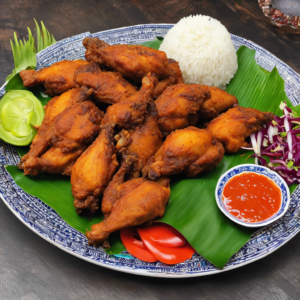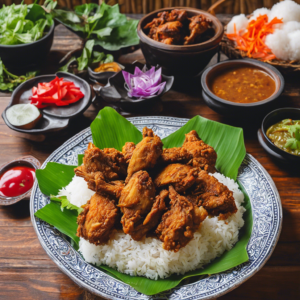Javanese cuisine is a treasure trove of delicious and unique flavors, and one of the most iconic dishes from this region is Opor Ayam. This dish is a true showcase of Javanese culinary heritage, with its delicate blend of spices and creamy coconut milk creating a flavor profile that is at once comforting and exotic.
Opor Ayam originates from the heart of Java, Indonesia’s most populous island, and is a staple dish in Javanese households, especially during festive occasions and celebrations. The dish consists of tender pieces of chicken cooked in a rich and creamy sauce made from a blend of spices and coconut milk. What sets Opor Ayam apart from other Indonesian dishes is its delicate balance of flavors and the time-honed traditional process of preparation.
The preparation of Genuine Javanese Opor Ayam is a labor of love and a testament to the care and attention that Javanese cuisine demands. The chicken is first simmered in a fragrant broth infused with lemongrass, galangal, and lime leaves, adding a subtle citrusy note to the dish. This slow-cooking process ensures that the chicken becomes tender and absorbs the delicate flavors of the broth. Then, the chicken is carefully removed and set aside, while the broth is transformed into a rich and creamy sauce.
The magic of Opor Ayam lies in the careful blend of spices. Ginger, garlic, shallots, and candlenuts are ground into a fine paste, creating a flavor base that is both complex and balanced. This spice paste is then sauteed in coconut oil until fragrant, releasing the rich aromas of each ingredient. The chicken is then added back to this aromatic mixture, along with a generous pouring of coconut milk, which gives the dish its signature creaminess and subtle sweetness.
The dish is then slowly simmered, allowing the flavors to meld together and create a harmonious taste sensation. The gravy thickens as it cooks, coating the chicken pieces in a luscious and decadent sauce. Genuine Javanese Opor Ayam is often served with a side of steamed white rice, which provides a neutral canvas to showcase the complex flavors of the dish.
Presentation is also an important aspect of this Javanese delicacy. Traditionally, Opor Ayam is presented in a clay pot, adding an earthy and rustic charm to the overall dining experience. The dish is often garnished with fried shallots and a sprinkling of fresh cilantro, adding a crisp texture and a bright, herbal note to the creamy dish.
The flavor of Genuine Javanese Opor Ayam is a symphony of tastes and aromas. The tender chicken melts in the mouth, with the creamy sauce coating each bite. The subtle heat from the spices warms the palate, while the coconut milk adds a hint of sweetness and richness. The fragrance of lemongrass and lime leaves lingers, providing a refreshing and uplifting note to the dish.
Genuine Javanese Opor Ayam has gained recognition beyond the shores of Java, with food enthusiasts and travelers seeking out this delicious treat. It has become a beloved dish among Indonesians of all ethnicities and has even found its way into the hearts (and stomachs) of people worldwide, thanks to its inclusion in international food festivals and cultural events.
The dish’s versatility also shines through as it can be adapted to suit various dietary preferences. For a vegetarian twist, tofu or tempeh can be substituted for chicken, absorbing the flavors of the spice paste and coconut milk just as effectively. This adaptation has made Opor Ayam accessible to a wider audience, showcasing the flexibility and inclusivity of Javanese cuisine.
In conclusion, Genuine Javanese Opor Ayam is a culinary masterpiece that embodies the essence of Javanese culture and tradition. Its intricate preparation, delicate balance of flavors, and versatile appeal make it a dish that truly deserves its place in the spotlight of Indonesian cuisine. Whether enjoyed during festive celebrations or as a comforting everyday meal, Opor Ayam is a delicious reminder of the richness and diversity of Javanese culinary heritage.




